1973 CHEVROLET CAMARO lights
[x] Cancel search: lightsPage 6 of 84
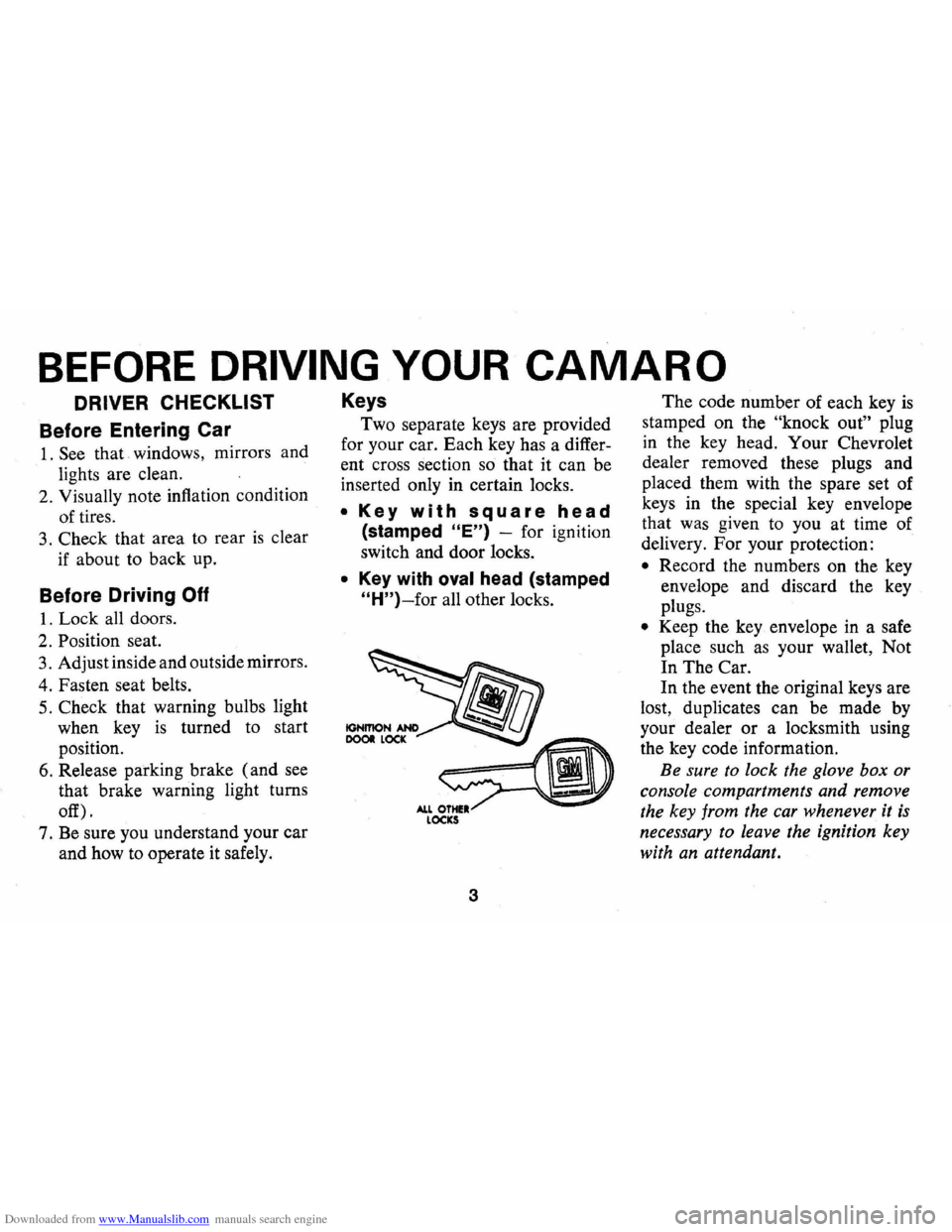
Downloaded from www.Manualslib.com manuals search engine BEFORE DRIVING YOUR CAMAR 0
DRIVER CHECKLIST
Before Entering Car
1. See that windows, mirrors and
lights are clean.
2. Visually note inflation condition
of tires.
3. Check that area to rear is clear
if about to back up.
Before Driving Off
1. Lock all doors.
2. Position seat.
3 . Adjust inside and outside mirrors.
4. Fasten seat belts.
5. Check that warning bulbs light
when key
is turned to start
position.
6. Release parking brake (and
see
that brake warning light turns
off) .
7. Be sure you understand your car
and how to operate it safely.
Keys
Two separate keys are provided
for your car. Each key has a differ
ent cross section
so that it can be
inserted only in certain locks.
• Key with square head
(stamped "E") -for ignition
switch and door locks.
• Key with oval head (stamped
"H")-for all other locks.
3
The code number of each key is
stamped on the "knock out" plug
in the key head. Your Chevrolet
dealer removed these plugs and
placed them with the spare set of
keys in the special key envelope
that was given to you at time of
delivery. For your protection:
• Record the numbers on the key
envelope and discard the key
plugs.
• Keep the key envelope in a safe
place such
as your wallet, Not
In The Car.
In the event the original keys are
lost, duplicates can be made by
your dealer
or a locksmith using
the key code information.
Be sure
to lock the glove box or
console compartments and remove
the key from the car whenever it
is
necessary to leave the ignition key
with an attendant.
Page 8 of 84
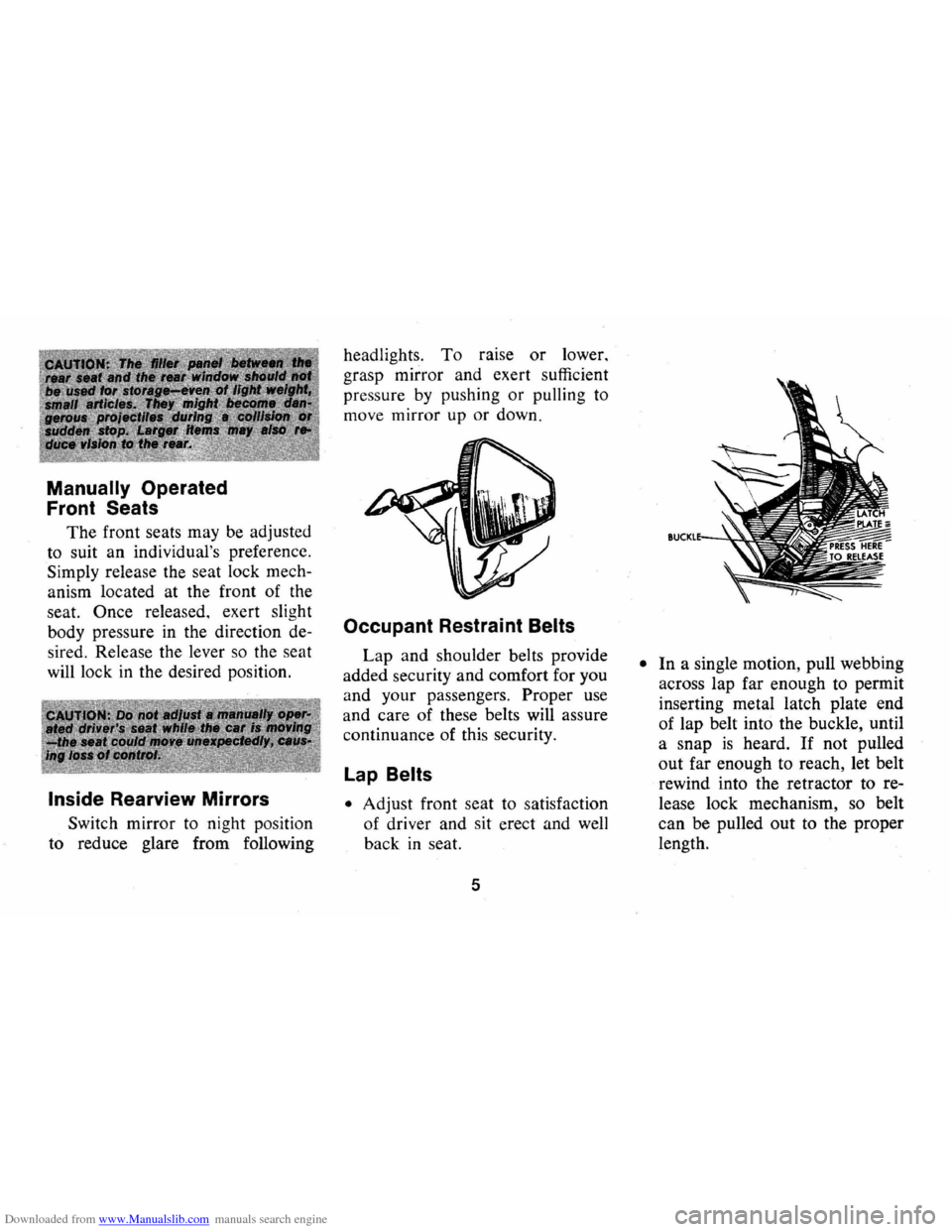
Downloaded from www.Manualslib.com manuals search engine Manually Operated
Front Seats
The front seats may be adjusted
to suit an individual's preference.
Simply release the seat lock mech
anism located at the front of the
seat.
Once released, exert slight
body pressure in the direction de
sired. Release the lever
so the seat
will lock in the desired position.
Inside Rearview Mirrors
Switch mirror to night position
to reduce glare from following headlights.
To raise or lower,
grasp mirror and exert sufficient
pressure
by pushing or pulling to
move mirror up
or down.
Occupant Restraint Belts
Lap and shoulder belts provide
added security and comfort for you
and your passengers.
Proper use
and care of these belts will assure
continuance of this security.
Lap Belts
• Adjust front seat to satisfaction
of driver and sit erect and
well
back in seat.
5
• In a single motion, pull webbing
across lap far enough to permit
inserting metal latch plate end
of lap belt into the buckle, until
a snap
is heard. If not pulled
out far enough to reach, let belt
rewind into the retractor to re
lease lock mechanism, so belt
can be pulled out to the proper
length.
Page 26 of 84
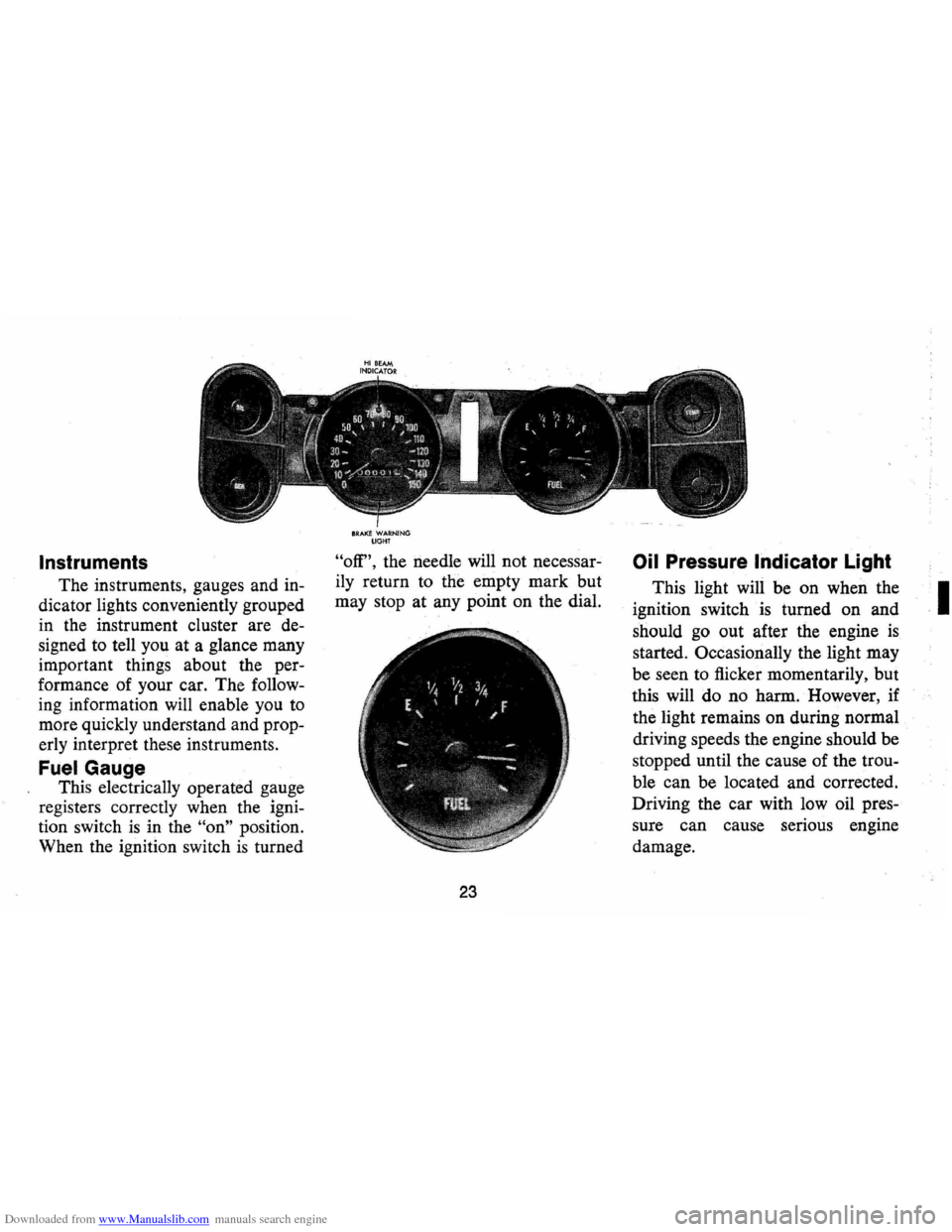
Downloaded from www.Manualslib.com manuals search engine Instruments
The instruments, gauges and in
dicator lights conveniently grouped
in the instrument cluster are de
signed to tell you at a glance many
important things about the per
formance of your car. The follow
ing information will enable you to
more quickly understand and prop
erly interpret these instruments .
Fuel Gauge
This electrically operated gauge
registers correctly when the igni
tion switch
is in the "on" position.
When the ignition switch
is turned
SRAKE WARNING UGHT
"off", the needle will not necessar
ily return to the empty mark but
may stop at any point on the dial.
23
Oil Pressure Indicator Light
This light will be on when the
ignition switch
is turned on and
should
go out after the engine is
started. Occasionally the light may
be seen to flicker momentarily, but
this will do no harm. However, if
the light remains on during normal
driving speeds the engine should be
stopped until the cause of the trou
ble can be located and corrected.
Driving the car with low oil pres
sure can cause serious engine
damage.
I
Page 28 of 84
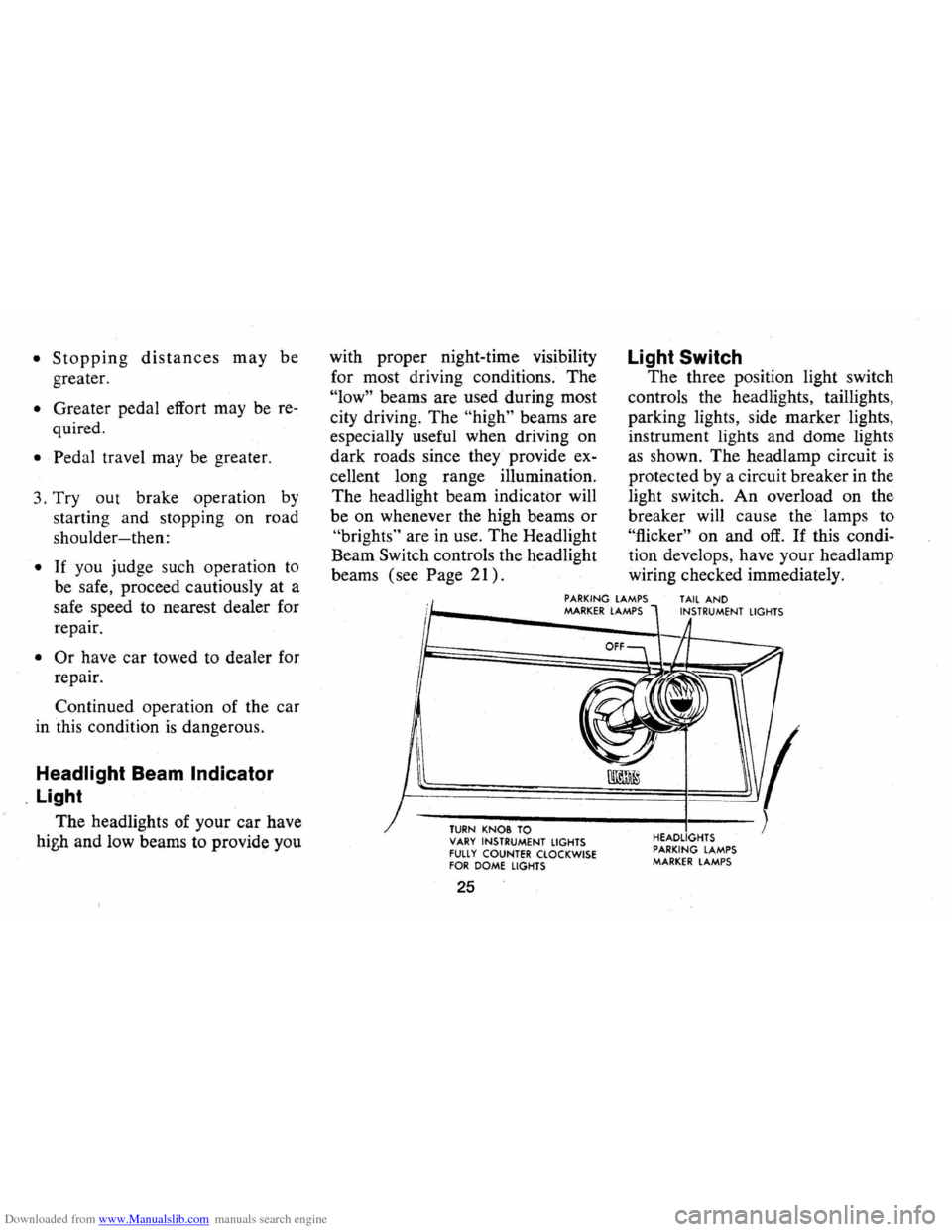
Downloaded from www.Manualslib.com manuals search engine • Stopping distances may be
greater.
• Greater pedal effort may be re
quired .
• Pedal travel may be greater.
3.
Tryout brake operation by
starting and stopping on road
shoulder-then:
• If you judge such operation to
be safe, proceed cautiously at a
safe speed to nearest dealer for
repair.
• Or have car towed to dealer for
repair.
Continued operation of the car
in this condition
is dangerous.
Headlight Beam Indicator
Light
The headlights of your car have
high and low
beams to provide you with
proper night-time visibility
for most driving conditions. The
"low" beams are used during most
city driving. The
"high" beams are
especially useful when driving on
dark roads since
they' provide ex
cellent long range illumination.
The headlight beam indicator will
be on whenever the high beams
or
"brights" are in use. The Headlight
Beam Switch controls the headlight
beams (see Page
21).
Light Switch
The three position light switch
controls the headlights, taillights,
parking lights, side marker lights,
instrument lights and dome lights
as shown. The headlamp circuit is
protected by a circuit breaker in the
light switch.
An overload on the
breaker will cause the lamps to
"flicker" on and off. If this condi
tion develops, have your headlamp
wiring checked immediately.
PARKING LAMPS MARKER LAMPS TAIL AND INSTRUMENT LIGHTS
TURN KN08 TO VARY INSTRUMENT LIGHTS FUll Y COUNTER CLOCKWISE FOR DOME LIGHTS
25
HEADLIGHTS
PARKING LAMPS MARKER LAMPS
Page 39 of 84
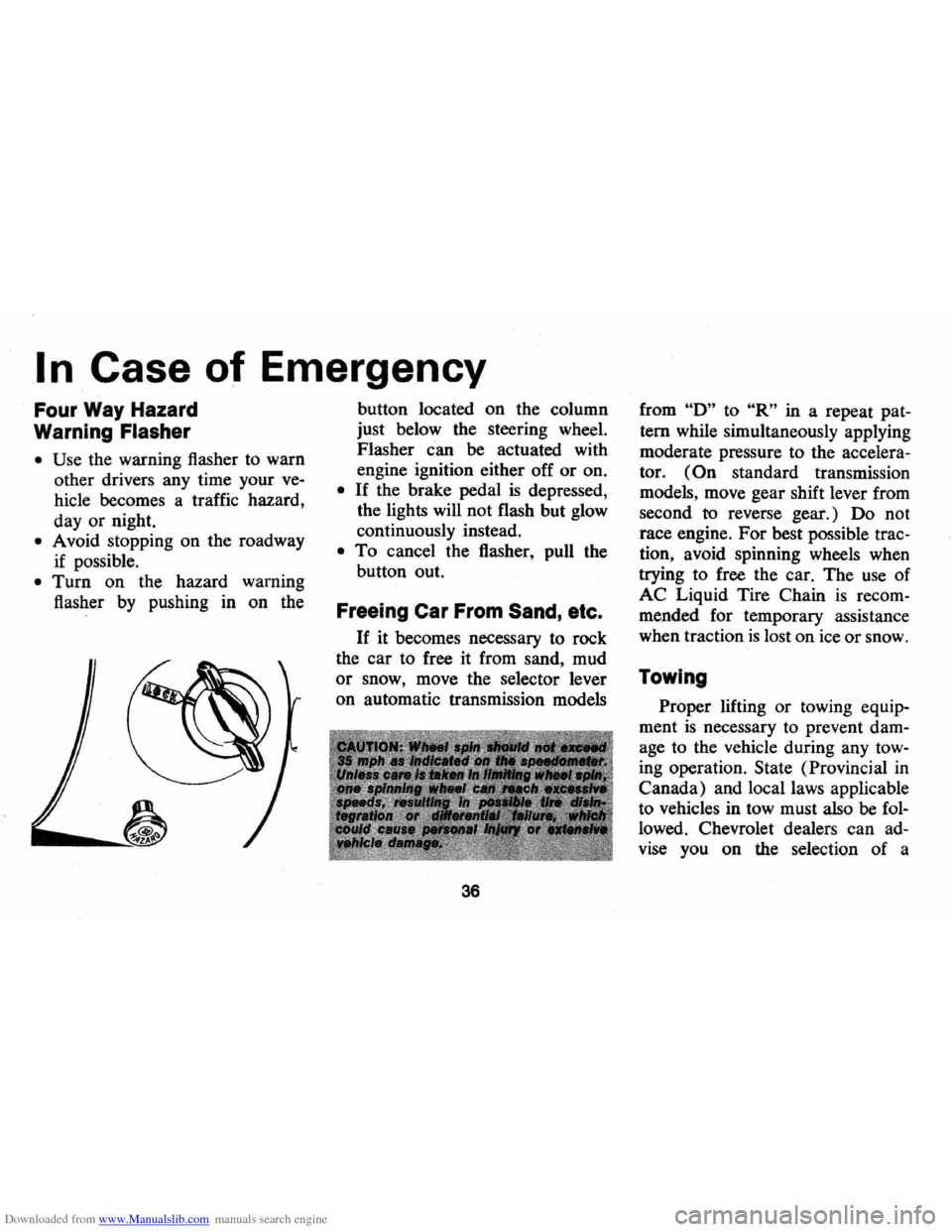
Downloaded from www.Manualslib.com manuals search engine .1 n Case of Emergency
Four Way Hazard
Warning Flasher
• Use the warning flasher to warn
other drivers any time your
ve·
hicle becomes a traffic hazard,
day or night.
• Avoid stopping on the roadway
if possible.
• Turn on the hazard warning
flasher
by pushing in on the
.---~
button located on the column
just below the steering wheel.
Flasher can be actuated with
engine ignition either off or on.
• If the brake pedal is depressed,
the lights will not flash but glow
continuously instead.
• To cancel the flasher, pull the
button out.
Freeing Car From Sand, etc.
If it becomes necessary to rock
the car to free it from sand, mud
or snow, move the selector lever
on automatic transmission models
36
from "0" to "R" in a repeat pat·
tern while simultaneously applying
moderate pressure to the
accelera
tor. (On standard transmission
models, move gear shift lever from
second
to reverse gear.) 00 not
race engine.
For best possible trac
tion, avoid spinning wheels when
trying to free the car. The use of
AC Liquid Tire Chain is recom
mended for temporary assistance
when traction
is lost on ice or snow.
Towing
Proper lifting or towing equip
ment is necessary to prevent dam
age to the vehicle during any tow
ing operation. State (Provincial in
Canada) and local laws applicable
to vehicles in tow must also be
fol
lowed . Chevrolet dealers can ad
vise you on the selection of a
Page 40 of 84
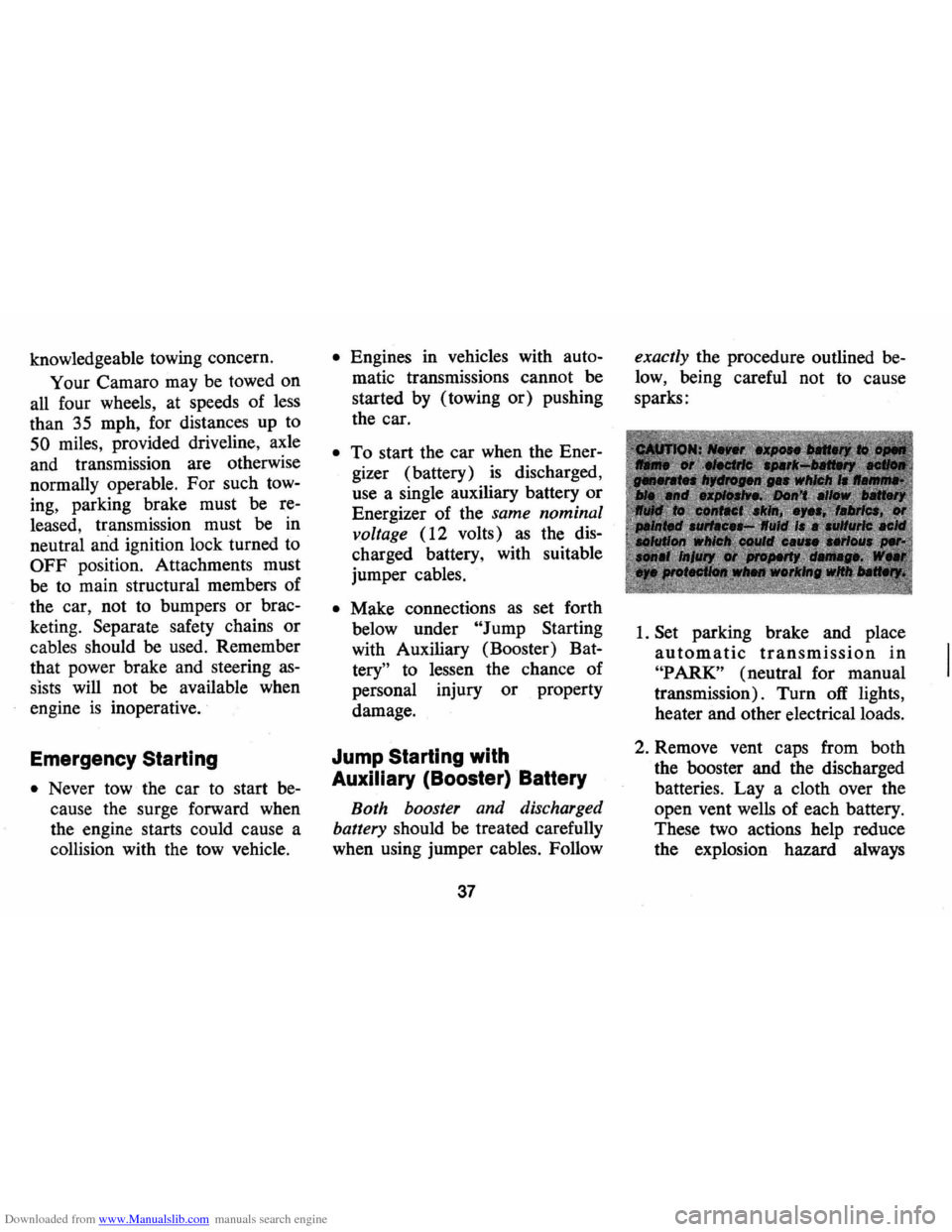
Downloaded from www.Manualslib.com manuals search engine knowledgeable towing concern.
Your Camaro may be towed on
all four wheels, at speeds of
less
than 35 mph, for distances up to
50 miles, provided driveline, axle
and transmission are otherwise
normally operable. For such tow
ing, parking brake must be re
leased, transmission must be in
neutral
and ignition lock turned to
OFF position. Attachments must
be to main structural members of
the car, not to bumpers or brac
keting. Separate safety chains
or
cables should be used. Remember
that power brake and steering
as
sists will not be available when
engine
is inoperative.
Emergency Starting
• Never tow the car to start be
cause the surge forward when
the engine starts could cause a
collision with the tow vehicle.
• Engines in vehicles with auto
matic transmissions cannot be
started by (towing
or) pushing
the car.
• To start the car when the Ener
gizer (battery)
is discharged,
use a single auxiliary battery or
Energizer of the same nominal
voltage
(12 volts) as the dis
charged battery, with suitable
jumper cables.
• Make connections as set forth
below under
"Jump Starting
with Auxiliary (Booster) Bat
tery" to lessen the chance of
personal injury
or property
damage.
Jump Starting with
Auxiliary (Booster) Battery
Both booster and discharged
battery should be treated carefully
when using jumper cables. Follow
37
exactly the procedure outlined be
low, being careful not to cause
sparks:
1. Set parking brake and place
automatic transmission in
"PARK" (neutral for manual
transmission). Turn
off lights,
heater and other electrical loads.
2. Remove vent caps from both
the booster and the discharged
batteries. Lay a cloth over the
open vent wells of each battery.
These two actions help reduce
the explosion hazard always
Page 67 of 84

Downloaded from www.Manualslib.com manuals search engine IE) If the car will start but stalls when hot or has a rough idle,
you can suspect a faulty IDLE ADJUSTMENT, a malfunctioning AUTOMATIC CHOKE or an extremely dirty and blocked AIR CLEANER ELEMENT. Replace paper element air cleaner if necessary. Idle adjustment or automatic choke service (other than that outlined in paragraph 0 above) should be performed by your
Chevrolet Dealer.
If the above Fuel System checks and the checks suggested under the Electrical System following do not correct the malfunction, it is recommended that you return to your Authorized Chevrolet Dealer
for further checks, adjustments or repairs.
ELECTRICAL SYSTEM If, when the ignition key is turned to "Start", the engine will not
turn over, you have good reason to suspect electrical trouble. NOTE: Never remove Delcotron bat lead without first disconnecting
battery ground cable.
IF) When there is no response at all to attempts to start the car, check the obvious-your AUTOMATIC TRANSMISSION SELECTOR LEVER must be in Neutral or Park position (manual transmission
must have clutch depressed all the way to floor) before the engine can be started. Turning the IGNITION SWITCH rapidly back and forth several times will sometimes correct a poor internal switch
contact.
IG) The BATIERY may be discharged. If so, lights will be dim and the horn will have a poor tone if it will blow at all.
Usually a garage recharge will be necessary to return the battery to operation. Occasionally, however, a long drive will recharge the battery. NOTE: If the battery is determined to be dead, and for no apparent reason, have your Authorized Chevrolet Dealer check the
battery, the GENERATOR and the VOLTAGE REGULATOR.
GENERATOR trouble should already have been indicated by the generator indicator light on the instrument panel.
64
POOR BATIERY CONNECTIONS may be suspected if the car has operated properly a short time before and now not even the horn
will operate. Check both ends of both battery cables. If the connections are corroded, a car may sometimes be restored to operation by removing all cable ends, scraping all contacting surfaces
clean with a pen knife, and reassembling. If the cables are broken,
they must be replaced. The power supply should now be restored
unless the battery is dead.
IH) If, however, the lights and horn work properly but the starter will still not turn over, check the STARTER connections. A "click" from the starter solenoid indicates that the wiring to the starter is properly installed. If the wiring seems to be clean and tightly in
stalled, the trouble is probably in the starter itself and should be referred to your Authorized Chevrolet Dealer.
When the engine will
"turn over" but will not start, the foilowing
items may be checked along with the Fuel Systems Checks listed
previously.
II) With a clean dry cloth, wipe the ceramic portions of the spark plugs dry. In particularly damp or rainy weather dampness may be
the cause of not sta rting, especi
ally when the engine is cold.
IJ) Check the cables at the top of the distributor and coil as well as each spark plug cable for
tightness.
IK) If the co r will still not sta rt,
check for spark at the spark plugs in the following manner:
Pull one of the spark plug
wires off its spark plug. Insert a
short piece of bare wire (such as Di.,ribu'or and Coil Cab I ••
Page 79 of 84
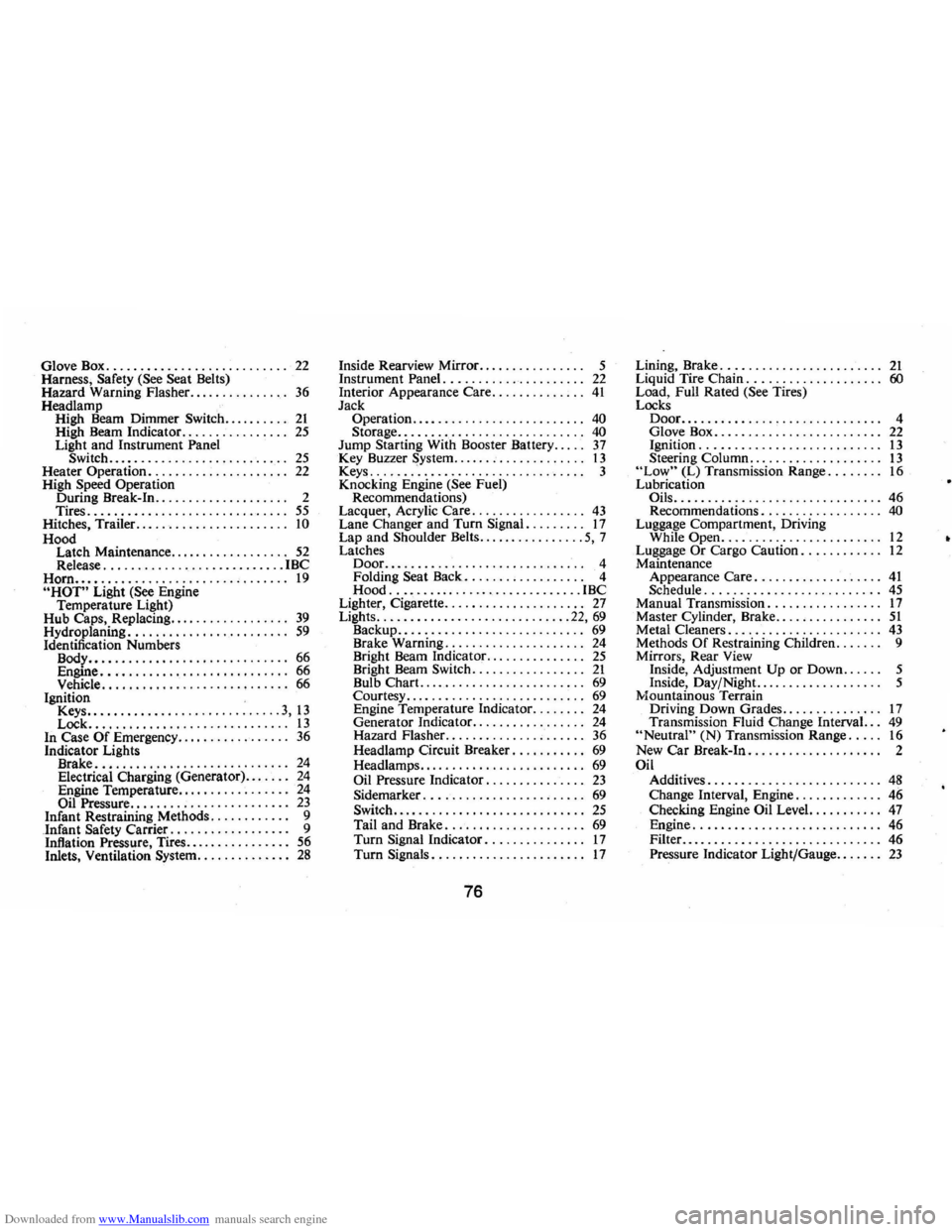
Downloaded from www.Manualslib.com manuals search engine Glove Box. . . . . . . . . . . . . . . . . . . . . . . . . .. 22 Harness, Safety (See Seat Belts)
Hazard VVarning Flasher .............. , 36 Headlamp High Beam Dimmer Switch .......... 21 High Beam Indicator.. . . . . . . . . . . . . .. 25 Light and Instrument Panel Switch ........................... 25 Heater Operation ..................... 22 High Speed Operation
During Break-In. . . . . . . . . . . . . . . . . . . . 2 Tires .............................. 55 Hitches, Trailer. .. . . . . . . . . . . . . . . . . . . .. 10 Hood Latch Maintenance .................. 52 Release ....................... .... IBC
Horn .... " .......................... 19 "HOT" Light (See Engine
Temperature Light)
Hub Caps, Replacing .................. 39 Hydroplaning. . . . . . . . . . . . . . .. . . . . . . . . 59 Identificat ion Numbers
~~J~~: : : : : : : : : : : : : : : : : : : : : : : : : : :: ~~ Vehicle .......... .................. 66 Ignition
Keys ............................. 3,13 Lock ... ........................... 13 In Case Of Emergency ................ , 36 Indicator Lights
Brake ............................. 24 Electrical Charging (Generator) ...... , 24 Engine Temperature ............. .. .. 24 Oil Pressure ....................... , 23 Infant Restraining Methods. . . . . . . . . . .. 9 Infant Safety Carrier. . . . . . . . . . . . . . . . . . 9
Intlation Pressure, Tires ................ 56 Inlets, Ventilation System .............. 28
Inside Rearview Mirror .......... , . .. .. 5 Instrument Panel . . . . . . . . . . . . . . . . . . . .. 22 Interior Appearance Care .............. 41 Jack
Operation .......................... 40 Storage ...... ......... ......... .... 40 Jump Starting VVith Booster Battery. . . .. 3 7 Key Buzzer System. . . . . . . . . . . . . . . . . . .. 13 Keys ....... '.............. ..... ...... 3 Knocking Engine (See Fuel)
Recommendations)
Lacquer, Acrylic Care
................. 43 Lan e Changer and Turn Signal. . . . . . . .. 17 Lap and Shoulder Belts ............... . 5 , 7 Latches Door.................. ............ 4 Folding Seat Ba ck ...... . ; . . . . . . . . .. 4 Hood . ........................... . IBC
Lighter, Cigarette ................. .... 27 Lights ............................. 22, 69 Backup .. ...... .................... 69 Brake VVarning ... .................. 24 Bright Beam Indicator. .............. 25 Bright Beam Switch ................. 21 Bulb Chart ....... ............ ...... 69 Courtesy . . . . . . . . . . . . . . . . . . . . . . . . . .. 69 Engine Temperature Indicator ........ 24 Generator Indicator.. . . . . . . . . . . . . . .. 24 Hazard Flasher .............. ; . . . . .. 36 H eadlamp Circuit Breaker. . . . . . . . . . . 69 Headlamps .......... ............... 69 Oil Pressure Indicator. . . . . . . . . . . . . .. 23 Sidemarker ... .............. ...... , 69 Switch ............................ . 25
Tail and Brake . . . . . . . . . . . . . . . . . . . .. 69 Turn Signal Indicator. . . . . . . . . . . . . .. 17 Turn Signals . . . . . . . . . . . . . . . . . . . . . . . 17
76
Lining, Brake ........................ 21 Liquid Tire Chain ............ ...... " 60
Load , Full Rated (See Tires)
Locks
Door.............................. 4 Glove Box ....................... " 22 Ignition . . . . . . . . . . . . . . . . . . . . . . . . . .. 13 Steering Column. . . . . . . . . . . . . . . . . . .. 13 "Low" (L) Transmission Range ........ 16 Lubrication Oils ....................... ........ 46
Recommendations. . . . . . . . . . . . . . . . .. 40 Luggage Compartment , Driving VVhile Open ......... ............. " 12 Luggage Or Cargo Caution . . . . . . . . . . .. 12 Maintenance
Appearance Care ................. " 41 Schedule. . . . . . . . . . . . . . . . . . . . . . . . .. 45 Manual Transmission ............... " 17 Master Cylinder , Brake .... , . . . . . . . . . . . 51 Metal Cleaners ... .. .... ............ " 43 Methods Of Re straining Children ..... .. 9 Mirrors, Rear View Inside, Adjustment Up or Down .... " 5 Inside, Day/Night.... . . . . . . . . . . . . . . . 5 Mountainous Terrain
Driving Down Grades ...... ... .... " 17 Transmission Fluid Change IntervaL.. 49 "Neutral" (N) Transmi ssion Range ..... 16 New Car Break-In .................. " 2 Oil Additives ........................ " 48 Change Interval, Engine ........... " 46 Checking Engine Oil Level. ........ " 47 Engine .......................... .. 46
Filter .................... .......... 46
Pressure Indicator Light/Gauge ..... " 23